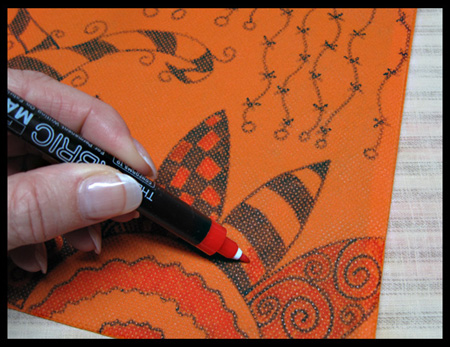
So as you know I’m working on a few Halloween crafty things. In this weekend’s blog post I’m going to share the instructions with you for several doodley projects to try on for size. And I also have a video showing you how I zipped through these in hardly any time at all…. well maybe it took a wee bit longer than shown in the video. 😉
Papier-mâché Skeleton Project
First up is a papier-mâché skeleton table top decoration. I’m not into creepy looking Halloween stuff as much as I am the silly sort of thing. However, when someone handed me this skull and asked me to doodle on it – well I made the best of it. This was a challenge to me for sure. Mitilda didn’t come out too creepy. I think she’s sorta fun looking. So anyway….
The steps for this project are pretty much the same as any other papier-mâché object. First create or buy a papier-mâché shape. I’m not going to go over how to create such a shape in this posting, but you can get instructions for that process from a lot of places on line simply by running a search from your browser. Insure your shape is completely dry before moving to the next step.
Then paint the piece with a solid color of your choice. When picking your color keep in mind that you’ll be doing your line-weaving over it using a contrasting color.
Similarly as you would if you were working on a flat surface, simply divide your large shape into smaller sections and then fill in each of the smaller sections with a repeat pattern design. Of course you can just doodle around on your project too – like I did with this skull. To accomplish your weaving you can use a permanent marker that writes on any paper surface or you could use paint that is thinned down to the consistency of ink. Apply your paint using a fine-line paint brush readily available in most any craft store.

When you’re finished with your line-weaving, you may want to spray your project with a fixative. Consider a clear spray paint or other such product from your local craft store.
Keep in mind that sometime marker inks don’t want to spread onto acrylic paint. And it’s not so much the ink as it is the pen tip. You may find that it will get dried up a bit. It may be helpful to have a scrap piece of paper near by to scribble on periodically to get the ink flowing again. Also consider using a roller-ball type ink pen. Find a place on your project that won’t show to do some test markings – like on the bottom side.
Canvas Treat Bag Project
Stitch up or purchase a small canvas bag. Again, I’m not going to go into detail on how to actually make the bag itself. If you decide not to purchase a ready made bag then I recommend you search the internet or your local fabric store pattern bin for detailed instructions on that.
If this is a bag you intend to use multiple times you may want to wash and dry it before moving onto the next step. This will insure the bag won’t shrink after you’ve added your design.
Iron out any wrinkles according to the care instructions for the fabric it’s made from. Cut a piece of cardboard or poster-board the size of the inside of your bag and slip it in. This provides a stiff surface to work on and it will also prevent any ink from running through to the other side of the bag.

You can use any sort of permanent ink marker that works on fabric such as a Micron, a pen made specifically for use on fabric, or fabric paint from a squeeze bottle to create your design on the bag. You may want to start with a random string like you do when tangling on paper, start in the middle and work your way out, or do what I did – start in one corner and let your imagination so wherever it wanders. The choice is really up to you. Consider sketching your patterns on paper before hand if you want to ensure everything fits on your bag in a certain way. Use just black or venture into additional colors if you prefer.
Keep in mind that the weave/thread count of your fabric will make a difference on how well your ink works on the bag. As with any ink-to-fabric type project do a few test lines in an un-noticable location to see how well your chosen tool will work.
Halloween Masks
Purchase (or make) a mask that has a smooth surface. I simply purchased some inexpensive plastic ones for this project. I like to paint mine with acrylic paint before doing any line weaving on it. This extra layer helps my drawing ink grip better and adds an extra color element as well. However, painting the surface may not be necessary if you like the way the surface is already. For the white and black one shown here I did not paint the mask before drawing on it.
If you opted to paint your mask – make sure the paint is dry and then use either a permanent ink marker (preferably alcohol based) or paint thinned to the consistency of ink to draw/paint your designs on the mask in whatever fashion suites you.

To add a bit of flair to your costume you may want to attach other embellishments such as feathers, jewels or ribbons. The choices for additional embellishments are nearly limitless. So have fun with it for sure!
Keep in mind that your ink may smudge if you are working directly on plastic. Do a few test lines on the back side and run your finger over the lines to see if they smear or need more drying time.
I found that both the Micron and Sharpie pens work well on these masks with the exception of the one painted with gold acrylic paint. On that one I had to use acrylic paint and a fine-line paint brush because my pen nibs didn’t seem to deliver the ink well. Something to do with the shiny surface maybe?
Crafty Video
Here’s a quick peek at me accomplishing these Halloween projects all tangled up with fun! Enjoy!
Have a great weekend everyone!
~ Cindy







Hi Cindy,
Great crafty projects. I am gaining a whole new appreciation for your blog!!
oxo,
Wally the Swamp Rat
Great videos of fun projects. These masks really turned out classy! Your work is great! Thanks for sharing! Andy
You just amaze me Cindy!!! Those are all super! TFS